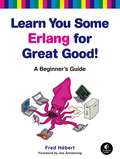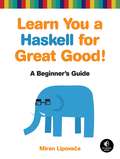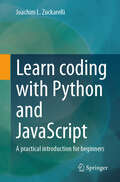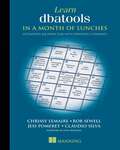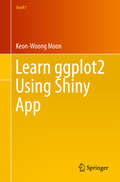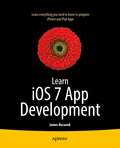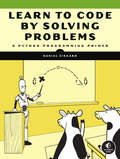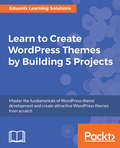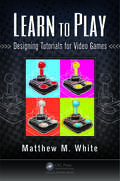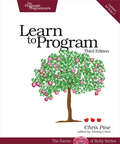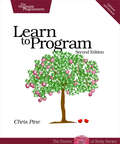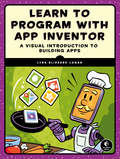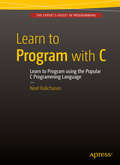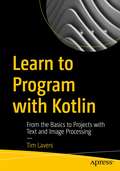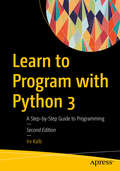- Table View
- List View
Learn You Some Erlang for Great Good!: A Beginner's Guide
by Fred HebertErlang is the language of choice for programmers who want to write robust, concurrent applications, but its strange syntax and functional design can intimidate the uninitiated. Luckily, there’s a new weapon in the battle against Erlang-phobia: Learn You Some Erlang for Great Good!Erlang maestro Fred Hébert starts slow and eases you into the basics: You’ll learn about Erlang’s unorthodox syntax, its data structures, its type system (or lack thereof!), and basic functional programming techniques. Once you’ve wrapped your head around the simple stuff, you’ll tackle the real meat-and-potatoes of the language: concurrency, distributed computing, hot code loading, and all the other dark magic that makes Erlang such a hot topic among today’s savvy developers.As you dive into Erlang’s functional fantasy world, you’ll learn about:–Testing your applications with EUnit and Common Test–Building and releasing your applications with the OTP framework–Passing messages, raising errors, and starting/stopping processes over many nodes–Storing and retrieving data using Mnesia and ETS–Network programming with TCP, UDP, and the inet module–The simple joys and potential pitfalls of writing distributed, concurrent applicationsPacked with lighthearted illustrations and just the right mix of offbeat and practical example programs, Learn You Some Erlang for Great Good! is the perfect entry point into the sometimes-crazy, always-thrilling world of Erlang.
Learn You a Haskell for Great Good!: A Beginner's Guide (No Starch Press Ser.)
by Miran Lipovaca<P>It's all in the name: Learn You a Haskell for Great Good! is a hilarious, illustrated guide to this complex functional language. Packed with the author's original artwork, pop culture references, and most importantly, useful example code, this book teaches functional fundamentals in a way you never thought possible. <P>You'll start with the kid stuff: basic syntax, recursion, types and type classes. Then once you've got the basics down, the real black belt master-class begins: you'll learn to use applicative functors, monads, zippers, and all the other mythical Haskell constructs you've only read about in storybooks. <P>As you work your way through the author's imaginative (and occasionally insane) examples, you'll learn to: <br>–Laugh in the face of side effects as you wield purely functional programming techniques <br>–Use the magic of Haskell's "laziness" to play with infinite sets of data <br>–Organize your programs by creating your own types, type classes, and modules <br>–Use Haskell's elegant input/output system to share the genius of your programs with the outside world <P>Short of eating the author's brain, you will not find a better way to learn this powerful language than reading Learn You a Haskell for Great Good!
Learn coding with Python and JavaScript: A practical introduction for beginners
by Joachim L. ZuckarelliWhether on the computer, tablet, mobile phone, in the car or in the coffee machine - computer programs determine our everyday life. Software is becoming increasingly important, hardly anything works without the mysterious power of algorithms. But how do programs work? And how do you develop them? This book teaches you the basics of programming. Using everyday examples, you will first learn the basic concepts of programming, which are similar in all programming languages. Based on these basic ideas, you will then learn two popular and very useful programming languages, Python and JavaScript, in a systematic way and with many practical exercises, which you can use for a wide range of different tasks. The book is aimed at novice programmers of all ages (from students to professionals) who have no previous programming experience.
Learn dbatools in a Month of Lunches: Automating SQL server tasks with PowerShell commands
by Chrissy LeMaire Rob Sewell Jess Pomfret Cláudio SilvaIf you work with SQL Server, dbatools is a lifesaver. This book will show you how to use this free and open source PowerShell module to automate just about every SQL server task you can imagine—all in just one month!In Learn dbatools in a Month of Lunches you will learn how to: Perform instance-to-instance and customized migrations Automate security audits, tempdb configuration, alerting, and reporting Schedule and monitor PowerShell tasks in SQL Server Agent Bulk-import any type of data into SQL Server Install dbatools in secure environments Written by a group of expert authors including dbatools creator Chrissy LeMaire, Learn dbatools in a Month of Lunches teaches you techniques that will make you more effective—and efficient—than you ever thought possible. In twenty-eight lunchbreak lessons, you&’ll learn the most important use cases of dbatools and the favorite functions of its core developers. Stabilize and standardize your SQL server environment, and simplify your tasks by building automation, alerting, and reporting with this powerful tool. About the technology For SQL Server DBAs, automation is the key to efficiency. Using the open-source dbatools PowerShell module, you can easily execute tasks on thousands of database servers at once—all from the command line. dbatools gives you over 500 pre-built commands, with countless new options for managing SQL Server at scale. There&’s nothing else like it. About the book Learn dbatools in a Month of Lunches teaches you how to automate SQL Server using the dbatools PowerShell module. Each 30-minute lesson introduces a new automation that will make your daily duties easier. Following the expert advice of dbatools creator Chrissy LeMaire and other top community contributors, you&’ll learn to script everything from backups to disaster recovery. What's inside Performing instance-to-instance and customized migrations Automating security audits, best practices, and standardized configurations Administering SQL Server Agent including running PowerShell scripts effectively Bulk-importing many types of data into SQL Server Executing advanced tasks and increasing efficiency for everyday administration About the reader For DBAs, accidental DBAs, and systems engineers who manage SQL Server. About the author Chrissy LeMaire is a GitHub Star and the creator of dbatools. Rob Sewell is a data engineer and a passionate automator. Jess Pomfret and Cláudio Silva are data platform architects. All are Microsoft MVPs. Table of Contents 1 Before you begin 2 Installing dbatools 3 The dbatools lab 4 A gentle introduction to dbatools commands 5 Writing to SQL Server 6 Finding SQL Server instances on your network 7 Inventorying your SQL estate 8 Registered Servers 9 Logins and users 10 Backups 11 Restore 12 Snapshots 13 Install and update SQL Server 14 Preparing for disaster 15 Performing your first advanced SQL Server instance migration, part 1 16 Performing your first advanced SQL Server instance migration, part 2 17 High availability and disaster recovery 18 PowerShell and SQL Server Agent 19 SQL Server Agent administration 20 Creating and working with SQL Server Agent objects 21 Data masking 22 DevOps automation 23 Tracing SQL Server activity 24 Security and encryption 25 Data compression 26 Validating your estate with dbachecks 27 Working in the cloud 28 dbatools configurations and logging 29 Never the end
Learn ggplot2 Using Shiny App
by Keon-Woong MoonThis book and app is for practitioners, professionals, researchers, and students who want to learn how to make a plot within the R environment using ggplot2, step-by-step without coding. In widespread use in the statistical communities, R is a free software language and environment for statistical programming and graphics. Many users find R to have a steep learning curve but to be extremely useful once overcome. ggplot2 is an extremely popular package tailored for producing graphics within R but which requires coding and has a steep learning curve itself, and Shiny is an open source R package that provides a web framework for building web applications using R without requiring HTML, CSS, or JavaScript. This manual--"integrating" R, ggplot2, and Shiny--introduces a new Shiny app, Learn ggplot2, that allows users to make plots easily without coding. With the Learn ggplot2 Shiny app, users can make plots using ggplot2 without having to code each step, reducing typos and error messages and allowing users to become familiar with ggplot2 code. The app makes it easy to apply themes, make multiplots (combining several plots into one plot), and download plots as PNG, PDF, or PowerPoint files with editable vector graphics. Users can also make plots on any computer or smart phone. Learn ggplot2 Using Shiny App allows users to Make publication-ready plots in minutes without coding Download plots with desired width, height, and resolution Plot and download plots in png, pdf, and PowerPoint formats, with or without R code and with editable vector graphics
Learn iOS 11 Programming with Swift 4 Second Edition: Learn The Fundamentals Of Ios App Development With Swift 4 And Xcode 9
by Craig Clayton<P><P>Begin your iOS development journey using Swift 4 and XCode 9 with this easy to learn, practical guide. <P><P>Key Features <P><P>Explore the latest features of iOS 11 and Swift 4 to build robust applications <P><P>Kickstart your iOS development career by building your first application from scratch <P><P>Manage databases and integrate standard elements such as photos and GPS into your app <P><P>Book Description <P><P>You want to build iOS applications but where do you start? Forget sifting through tutorials and blog posts, this book is a direct route into iOS development, taking you through the basics and showing you how to put the principles into practice. So take advantage of this developer-friendly guide and start building applications that may just take the App Store by storm! <P><P>Whether you're an experienced programmer or a complete novice, this book guides you through every facet of iOS development. From Xcode and Swift, the building blocks of modern iOS development, you'll quickly gain a solid foundation to begin venturing deeper into your development journey. Experienced programmers can jump right in and learn the latest iOS 11 features. <P><P>You'll also learn advanced topics of iOS design, such as gestures and animations, to give your app the edge. Explore the latest developments in Swift 4 and iOS 11 by incorporating new features, custom-rich notifications, drag and drop features, and the latest developments in SiriKit. With further guidance on beta testing with TestFlight, you'll quickly learn everything you need to get your project on the App Store! <P><P>What you will learn <P><P>Get to grips with Swift 4 and Xcode 9, the building blocks of Apple development <P><P>Get to know the fundamentals of Swift 4, including strings, variables, constants, and control flow <P><P>Discover the distinctive design principles that define the iOS user experience <P><P>Build a responsive UI and add privacy to your custom-rich notifications <P><P>Preserve data and manipulate images with filters and effects <P><P>Bring in SiriKit to create payment requests inside your app <P><P>Collect valuable feedback with TestFlight before you release your apps on the App Store <P><P>Who This Book Is For <P><P>This book is for beginners who want to be able to create iOS applications. You do not need any knowledge of Swift or any prior programming experience. However, if you have some programming experience, this book is a great way to get a full understanding of how to create an iOS application from scratch and submit it to the App Store
Learn iOS 11 Programming with Swift 4: Learn the fundamentals of iOS app development with Swift 4 and Xcode 9
by Craig ClaytonBegin your iOS development journey using Swift 4 and XCode 9 with this easy to learn, practical guide. Key Features Explore the latest features of iOS 11 and Swift 4 to build robust applications Kickstart your iOS development career by building your first application from scratch Manage databases and integrate standard elements such as photos and GPS into your app Book Description You want to build iOS applications but where do you start? Forget sifting through tutorials and blog posts, this book is a direct route into iOS development, taking you through the basics and showing you how to put the principles into practice. So take advantage of this developer-friendly guide and start building applications that may just take the App Store by storm! Whether you're an experienced programmer or a complete novice, this book guides you through every facet of iOS development. From Xcode and Swift, the building blocks of modern iOS development, you'll quickly gain a solid foundation to begin venturing deeper into your development journey. Experienced programmers can jump right in and learn the latest iOS 11 features. You'll also learn advanced topics of iOS design, such as gestures and animations, to give your app the edge. Explore the latest developments in Swift 4 and iOS 11 by incorporating new features, custom-rich notifications, drag and drop features, and the latest developments in SiriKit. With further guidance on beta testing with TestFlight, you'll quickly learn everything you need to get your project on the App Store! What you will learn Get to grips with Swift 4 and Xcode 9, the building blocks of Apple development Get to know the fundamentals of Swift 4, including strings, variables, constants, and control flow Discover the distinctive design principles that define the iOS user experience Build a responsive UI and add privacy to your custom-rich notifications Preserve data and manipulate images with filters and effects Bring in SiriKit to create payment requests inside your app Collect valuable feedback with TestFlight before you release your apps on the App Store Who this book is for This book is for beginners who want to be able to create iOS applications. You do not need any knowledge of Swift or any prior programming experience. However, if you have some programming experience, this book is a great way to get a full understanding of how to create an iOS application from scratch and submit it to the App Store
Learn iOS 8 App Development
by James BucanekLearn iOS 8 App Development is both a rapid tutorial and a useful reference. You'll quickly get up to speed with Swift, Cocoa Touch, and the iOS 8 SDK. It's an all-in-one getting started guide to building useful apps. You'll learn best practices that ensure your code will be efficient and perform well, earning positive reviews on the iTunes App Store, and driving better search results and more revenue. The iOS 8 SDK offers powerful new features, and this book is the fastest path to mastering them--and the rest of the iOS SDK --for programmers with some experience who are new to iPhone and iPad app development. Many books introduce the iOS SDK, but few explain how to develop apps optimally and soundly. This book teaches both core Swift language concepts and how to exploit design patterns and logic with the iOS SDK, based on Swift and the Cocoa Touch framework. Why spend months or years discovering the best ways to design and code iPhone and iPad apps when this book will show you how to do things the right way from the start? Get an accelerated treatment of the core fundamentals of Swift. Develop your first app using Xcode's advanced interface design tools. Build your first iPhone app using the code that you're given as you walk through this book. Finally, debug and distribute your first app on Apple's iTunes App Store. Learn how to create apps for any model of iPhone, the iPod Touch, the iPad, or build universal apps that run on all of them. After reading this book, you'll be creating professional quality apps, ready to upload to the app store, making you the prestige and the money you seek
Learn iOS Application Distribution
by Hagop PanosianCover every aspect of the app industry, from app idea generation through to marketing and performance monitoring. With this book you'll receive complete, reliable, up-to-date, and professional information and guidance. Learn iOS App Distribution is every developers thorough and accessible guide to successfully distributing apps. For readers who already know how to code and create apps, this book explains how the app industry works, how it is evolving, and what the key trends are. Rather than focus on the well-covered aspects of working with Swift and Xcode, you'll instead discover what it takes from a commercial standpoint to bring an app together and get it successfully out to customers. All the key technical aspects are simplified for you with non-technical backgrounds, and vast amounts of information are condensed into easy-to-understand visuals. What You'll Learn Review how the app industry nuances and how it works Analyze app statistics and key market trends Position an app appropriately within the industry Improve app performance and related products and services Who This Book Is For App designers, UI/UX design professionals, coders, app marketers, game designers, asset designers and app publishing companies. The book is also suitable for inventors and non-tech readers unfamiliar with the industry but interested in investing in apps
Learn pfSense 2.4: Get up and running with Pfsense and all the core concepts to build firewall and routing solutions
by David ZientaraInstall, Configure and Setup different connections with pfSenseKey FeaturesBuild firewall and routing solutions with PfSense.Learn how to create captive portals, how to connect Pfsense to your https environment and so on.Practical approach towards building firewall solutions for your organizationBook DescriptionAs computer networks become ubiquitous, it has become increasingly important to both secure and optimize our networks. pfSense, an open-source router/firewall, provides an easy, cost-effective way of achieving this – and this book explains how to install and configure pfSense in such a way that even a networking beginner can successfully deploy and use pfSense.This book begins by covering networking fundamentals, deployment scenarios, and hardware sizing guidelines, as well as how to install pfSense. The book then covers configuration of basic services such as DHCP, DNS, and captive portal and VLAN configuration. Careful consideration is given to the core firewall functionality of pfSense, and how to set up firewall rules and traffic shaping. Finally, the book covers the basics of VPNs, multi-WAN setups, routing and bridging, and how to perform diagnostics and troubleshooting on a network.What you will learnInstall pfSenseConfigure additional interfaces, and enable and configure DHCPUnderstand Captive portalUnderstand firewalls and NAT, and traffic shapingLearn in detail about VPNsUnderstand Multi-WANLearn about routing and bridging in detailUnderstand the basics of diagnostics and troubleshooting networksWho this book is forThis book is towards any network security professionals who want to get introduced to the world of firewalls and network configurations using Pfsense. No knowledge of PfSense is required
Learn to Code by Solving Problems: A Python Programming Primer
by Daniel ZingaroLearn to Code by Solving Problems is a practical introduction to programming using Python. It uses coding-competition challenges to teach you the mechanics of coding and how to think like a savvy programmer.Computers are capable of solving almost any problem when given the right instructions. That&’s where programming comes in. This beginner&’s book will have you writing Python programs right away. You&’ll solve interesting problems drawn from real coding competitions and build your programming skills as you go. Every chapter presents problems from coding challenge websites, where online judges test your solutions and provide targeted feedback. As you practice using core Python features, functions, and techniques, you&’ll develop a clear understanding of data structures, algorithms, and other programming basics. Bonus exercises invite you to explore new concepts on your own, and multiple-choice questions encourage you to think about how each piece of code works. You&’ll learn how to: • Run Python code, work with strings, and use variables • Write programs that make decisions • Make code more efficient with while and for loops • Use Python sets, lists, and dictionaries to organize, sort, and search data • Design programs using functions and top-down design • Create complete-search algorithms and use Big O notation to design more efficient code By the end of the book, you&’ll not only be proficient in Python, but you&’ll also understand how to think through problems and tackle them with code. Programming languages come and go, but this book gives you the lasting foundation you need to start thinking like a programmer.
Learn to Code with Games
by John M. QuickA novel approach for the classroom or self-study, Learn to Code with Games makes coding accessible to a broad audience. Structured as a series of challenges that help you learn to code by creating a video game, each chapter expands and builds your knowledge while providing guidelines and hints to solving each challenge.The book employs a unique pro
Learn to Create WordPress Themes by Building 5 Projects.: Master the fundamentals of WordPress theme development and create attractive WordPress themes from scratch
by Eduonix Learning Solution Pvt. LtdKey Features Learn the basics of WordPress theme development in a step by step manner Make your themes more dynamic by integrating components of Bootstrap and JQuery 5 carefully-selected projects to help you get beyond the theory and create highly marketable WordPress themes from scratch Book Description WordPress has emerged as a powerful, easy-to-use tool to design attractive, engaging websites. Themes play a big role in making WordPress as popular as it is today, and having an eye-catching, fully-functional theme could separate your website from the rest! This book will help you take your first steps in the WordPress theme development process, with 5 different projects centered around creating unique and responsive WordPress themes. Start with creating a simple WordPress theme using HTML5, CSS, and PHP. Then, you will move on to incorporate different APIs, widgets, and tools such as Bootstrap and jQuery to create more dynamic and highly-functional themes. Whether you want to create a photo gallery theme, a highly customizable e-commerce theme, or a theme designed to suit a particular business, this book will teach you everything you need to know. By the end of this highly interactive book, you will have the required mastery to develop WordPress themes from scratch. What you will learn Simple and advanced themes – covers basic syntax and files along with archives and search pages Photo Gallery – add simple animation and use the W3.CSS framework to design a photo gallery theme Wordstrap – incorporate Twitter Bootstrap into the theme and use the WP_NavWalker class E-commerce theme – build an e-commerce theme using the Foundation framework
Learn to Implement Games with Code
by John M. QuickGame development is one of the most rewarding crafts of modern times. Not only is making games a wonderful lifelong hobby, but employment opportunities exist at many levels. Learn to Implement Games with Code guides you through the development process as you put together a release-ready game. It is written in a friendly and conversational tone, which is suitable for a wide audience of aspiring game developers, such as yourself. You will gain practical, hands-on experience with implementing game components using code. Gradually, you will build a complete game that you can be proud of. After finishing this book, you will be prepared to start making games of your very own design.
Learn to Play: Designing Tutorials for Video Games
by Matthew M. WhiteSee How to Unobtrusively Incorporate Good Teaching into Your Game's MechanicsLearn to Play: Designing Tutorials for Video Games shows how to embed a tutorial directly into your game design mechanics so that your games naturally and comfortably teach players to have fun. The author deciphers years of research in game studies, education, psychology,
Learn to Program
by Chris PineIt's easier to learn how to program a computer than it has ever been before. Now everyone can learn to write programs for themselves - no previous experience is necessary. Chris Pine takes a thorough, but lighthearted approach that teaches you the fundamentals of computer programming, with a minimum of fuss or bother. Whether you are interested in a new hobby or a new career, this book is your doorway into the world of programming.Computers are everywhere, and being able to program them is more important than it has ever been. But since most books on programming are written for other programmers, it can be hard to break in.At least it used to be. Chris Pine will teach you how to program. You'll learn to use your computer better, to get it to do what you want it to do. Starting with small, simple one-line programs to calculate your age in seconds, you'll see how to write interactive programs, to use APIs to fetch live data from the internet, to rename your photos from your digital camera, and more. You'll learn the same technology used to drive modern dynamic websites and large, professional applications.Whether you are looking for a fun new hobby or are interested in entering the tech world as a professional, this book gives you a solid foundation in programming. Chris teaches the basics, but also shows you how to think like a programmer. You'll learn through tons of examples, and through programming challenges throughout the book. When you finish, you'll know how and where to learn more - you'll be on your way.What You Need:All you need to learn how to program is a computer (Windows, macOS, or Linux) and an internet connection. Chris Pine will lead you through setting set up with the software you will need to start writing programs of your own.
Learn to Program (Facets of Ruby)
by Chris PinePrinted in full color.For this new edition of the best-selling Learn to Program, Chris Pine has taken a good thing and made it even better. First, he used the feedback from hundreds of reader e-mails to update the content and make it even clearer. Second, he updated the examples in the book to use the latest stable version of Ruby, and also to use code that looks more like real-world Ruby code, so that people who have just learned to program will be more familiar with common Ruby techniques. Not only does the Second Edition now include answers to all of the exercises, it includes them twice. First you'll find the "how you could do it" answers, using the techniques you've learned up to that point in the book. Next you'll see "how Chris Pine would do it": answers using more advanced Ruby techniques, to whet your appetite as well as providing sort of a "Rosetta Stone" for more elegant solutions.Computers are everywhere, on every desk, in your iPod, cell phone, and PDA. To live well in the 21st century, you need to know how to make computers do things. And to really make computers do what you want, you have to learn to program. Fortunately, that's easier now than ever before. Chris Pine's book will teach you how to program. You'll learn to use your computer better, to get it to do what you want it to do. Starting with small, simple one-line programs to calculate your age in seconds, you'll see how to advance to fully structured, real programs. You'll learn the same technology used to drive modern dynamic websites and large, professional applications.It's now easier to learn to write your own computer software than it has ever been before. Now everyone can learn to write programs for themselves---no previous experience is necessary. Chris takes a thorough, but light-hearted approach that teaches you how to program with a minimum of fuss or bother.Printed in full color.
Learn to Program with App Inventor: A Visual Introduction to Building Apps
by Lyra LoganLearn to build mobile apps for Android devices with MIT App Inventor, a visual drag-and-drop programming language like Scratch.You've swiped and tapped your way through countless apps, but have you ever created one? Now you can, thanks to Learn to Program with App Inventor. In less than an hour, you'll be able to build and run your first app!App Inventor is a free software for making Android apps. All you need is a PC with an Internet connection to build your app, and a mobile phone for testing. You'll use a simple drag-and-drop interface, which minimizes errors and avoids too much typing. A certified App Inventor Master Trainer, Logan breaks down each project into logical steps, lists the components you'll need, and then shows you how to create screen designs, control program flow with conditionals and loops, and store data in variables and lists. Once you've tested the app on your phone, you can test what you learned with challenges at the end of each chapter.You'll build cool apps like: * Hi, World!: Use your voice to send a text message * Practice Makes Perfect: Rehearse a speech or dance routine with this video recording app * Fruit Loot: Catch randomly failing fruit in this exciting game * Beat the Bus: Track a friend's journey using location services and maps * Virtual Shades: Take a selfie, then try on some virtual sunglassesJoin the 6 million people who have tried App Inventor, and make the journey from app user to app inventor.
Learn to Program with Assembly: Foundational Learning for New Programmers
by Jonathan BartlettMany programmers have limited effectiveness because they don't have a deep understanding of how their computer actually works under the hood. In Learn to Program with Assembly, you will learn to program in assembly language - the language of the computer itself. Assembly language is often thought of as a difficult and arcane subject. However, author Jonathan Bartlett presents the material in a way that works just as well for first-time programmers as for long-time professionals. Whether this is your first programming book ever or you are a professional wanting to deepen your understanding of the computer you are working with, this book is for you. The book teaches 64-bit x86 assembly language running on the Linux operating system. However, even if you are not running Linux, a provided Docker image will allow you to use a Mac or Windows computer as well.The book starts with extremely simple programs to help you get your grounding, going steadily deeper with each chapter. At the end of the first section, you will be familiar with most of the basic instructions available on the processor that you will need for any task. The second part deals with interactions with the operating system. It shows how to make calls to the standard library, how to make direct system calls to the kernel, how to write your own library code, and how to work with memory. The third part shows how modern programming language features such as exception handling, object-oriented programming, and garbage collection work at the assembly language level. Additionally, the book comes with several appendices covering various topics such as running the debugger, vector processing, optimization principles, a list of common instructions, and other important subjects.This book is the 64-bit successor to Jonathan Bartlett's previous book, Programming from the Ground Up, which has been a programming classic for more than 15 years. This book covers similar ground but with modern 64-bit processors, and also includes a lot more information about how high level programming language features are implemented in assembly language.What You Will LearnHow the processor operates How computers represent data internally How programs interact with the operating systemHow to write and use dynamic code librariesHow high-level programming languages implement their features Who This Book Is ForAnyone who wants to know how their computer really works under the hood, including first time programmers, students, and professionals.
Learn to Program with C
by Noel KalicharanLearn to Program with C teaches computer programming to the complete beginner using the native C language. As such, it assumes you have no knowledge whatsoever about programming. The main goal of this book is to teach fundamental programming principles using C, one of the most widely used programming languages in the world today. We discuss only those features and statements in C that are necessary to achieve our goal. Once you learn the principles well, they can be applied to any language. If you are worried that you are not good at high-school mathematics, don't be. It is a myth that you must be good at mathematics to learn programming. C is considered a 'modern' language even though its roots date back to the 1970s. Originally, C was designed for writing 'systems' programs--things like operating systems, editors, compilers, assemblers and input/output utility programs. But, today, C is used for writing all kinds of applications programs as well--word processing programs, spreadsheet programs, database management programs, accounting programs, games, robots, embedded systems/electronics (i. e. , Arduino), educational software--the list is endless. Note: Appendices A-D are available as part of the free source code download on apress. com. What you'll learn How to get started with programming using the C language How to use the basics of C How to program with sequence, selection and repetition logic How to work with characters How to work with functions How to use arrays Who this book is for This book is intended for anyone who is learning programming for the first time, regardless of age or institution. Table of Contents 1. Elementary Programming Concepts 2. C The Basics 3. Programs with Sequence Logic 4. Programs with Selection Logic 5. Programs with Repetition Logic 6. Working with Characters and Strings 7. Working with Functions 8. Working with Arrays 9. Working with Structures A. Keywords in C B. ASCII C. Integers D. C Compilers
Learn to Program with Kotlin: From the Basics to Projects with Text and Image Processing
by Tim LaversTeach yourself programming starting with the basics and progressing to a series of exciting projects using Kotlin, one of today's hottest programming languages. This book starts with the absolute basics and then introduces just enough syntax to get into some fascinating projects. These include text processing: a statistical analysis of Jane Austen's novels, solving anagrams, and working with palindromes; image processing: cropping and resizing images, and pixel transformation; and computer vision: finding digits, parsing images, and reading speed signs. The projects are developed in tiny steps and complete solutions are provided. Some of these projects include core data science concepts, giving you skills in one of the most important areas of modern programming. Along the way you’ll cover functional programming, object-oriented programming (OOP), refactoring, and writing unit tests. After reading Learn to Program with Kotlin, you'll come away with practical insights and code to get you started right away with programming using Kotlin for your own projects. What You Will Learn Gain the basics of Kotlin using the IntelliJ Java IDE Implement OOP with Kotlin along with unit testing and code refactoring using a series of text-related projects Harness functional programming with Kotlin by building an image-processing library Write software to locate and read speed signs in photos Who Is This Book For Anyone who wants to learn how to program or code from scratch. Also great for experienced programmers who want to know more about Kotlin.
Learn to Program with Minecraft Plugins: Create Flaming Cows in Java Using CanaryMod
by Andy HuntThe first edition of this book used the Bukkit modding server and library, which was taken down due to a legal dispute in September 2014. This new edition has been completely revised to replace Bukkit with the CanaryMod library.The bestselling, kid-tested book for Minecraft is now updated for CanaryMod! Write your own Minecraft plugins and watch your code come to life with flaming cows, flying creepers, teleportation, and interactivity. Add your own features to the Minecraft game by developing Java code that "plugs in" to the server. You'll manipulate and control elements in the 3D graphical game environment without having to write tons of code or learn huge frameworks. No previous programming experience necessary.Expand your Minecraft experience! You'll learn how to write Java code and build plugins for your own Minecraft servers using the popular Java programming language. This new edition has been completely revised to use the freely-available CanaryMod library.You'll create plugins that can change blocks from air to stone, or spawn cows and creepers. You'll write plugins that react to game events, and even schedule tasks that will run later in the game. Readers from age 9 to 99 will learn how to use variables and functions to build plugins that fling players into the sky, create flying creepers, and of course, shoot flaming cows.Along the way you'll learn real programming using Java, from classes, objects, and data structures (including arrays and hashes) to exception handling and threads. You'll even learn how to back up your code (and go back in time!) using Git, and run your own server at home or in the cloud. A progress bar shows you how far you've come in each chapter, and by the end of the book you'll be able to design and code your own plugins.Put your gaming to good use, and learn real programming skills today.What You Need:A modern PC running the Windows, Mac OS X, or Linux operating systems. The book explains how to download Java, the CanaryMod server and API, and all the tools you'll need.
Learn to Program with Minecraft: Transform Your World with the Power of Python
by Craig RichardsonYou’ve bested creepers, traveled deep into caves, and maybe even gone to The End and back—but have you ever transformed a sword into a magic wand? Built a palace in the blink of an eye? Designed your own color-changing disco dance floor?In Learn to Program with Minecraft®, you’ll do all this and more with the power of Python, a free language used by millions of professional and first-time programmers!Begin with some short, simple Python lessons and then use your new skills to modify Minecraft to produce instant and totally awesome results. Learn how to customize Minecraft to make mini-games, duplicate entire buildings, and turn boring blocks into gold.You’ll also write programs that:–Take you on an automated teleportation tour around your Minecraft world–Build massive monuments, pyramids, forests, and more in a snap!–Make secret passageways that open when you activate a hidden switch–Create a spooky ghost town that vanishes and reappears elsewhere–Show exactly where to dig for rare blocks–Cast a spell so that a cascade of flowers (or dynamite if you’re daring!) follows your every move–Make mischief with dastardly lava traps and watery curses that cause huge floodsWhether you’re a Minecraft megafan or a newbie, you’ll see Minecraft in a whole new light while learning the basics of programming. Sure, you could spend all day mining for precious resources or building your mansion by hand, but with the power of Python, those days are over!Requires: Windows 7 or later; OS X 10.10 or later; or a Raspberry Pi. Uses Python 3
Learn to Program with Python
by Irv KalbGet started in the world of software development: go from zero knowledge of programming, through variables, assignment operators, functions, string manipulation, data and networking, and finally into game programming. Along the way you'll learn about Python and its IDLE IDE, which you'll use to write and debug all your Python apps. In Learn to Program with Python author Irv Kalb uses his in-person teaching experience to guide you through learning the Python computer programming language. He uses a very conversational style to make you feel as though he is your personal tutor. All material is laid out in a thoughtful manner, each lesson building on the previous lesson. And, examples are provided along the way, including a game app example using the PyGame extension. What you'll learn Use fundamental concepts including variables, functions, if/else statements, loops, and lists Work with the IDLE IDE to write and debug your Python programs Build simple text-based programs Manipulate your data using Python's built-in features Harness the PyGame extension to write games Who this book is for This book assumes that you have absolutely no prior knowledge about programming. There is no need to learn or use any obscure Unix commands. Students of any age who have had no exposure to programming and are interested in learning to do software development in the Python language. The book can be used as a text book associated with a high school or college introduction to computer science course. Secondly, people who have had exposure to some computer language other than Python, who would like to build good habits for programming in Python.
Learn to Program with Python 3: A Step-by-step Guide To Programming
by Irv KalbMove from zero knowledge of programming to comfortably writing small to medium-sized programs in Python. Fully updated for Python 3, with code and examples throughout, the book explains Python coding with an accessible, step-by-step approach designed to bring you comfortably into the world of software development.Real–world analogies make the material understandable, with a wide variety of well-documented examples to illustrate each concept. Along the way, you’ll develop short programs through a series of coding challenges that reinforce the content of the chapters.Learn to Program with Python 3 guides you with material developed in the author's university computer science courses. The author's conversational style feels like you're working with a personal tutor. All material is thoughtfully laid out, each lesson building on previous ones. What You'll Learn Understand programming basics with Python, based on material developed in the author's college coursesLearn core concepts: variables, functions, conditionals, loops, lists, strings, and moreExplore example programs including simple games you can program and customizeBuild modules to reuse your own codeWho This Book Is ForThis book assumes no prior programming experience, and would be appropriate as text for a high school or college introduction to computer science.
